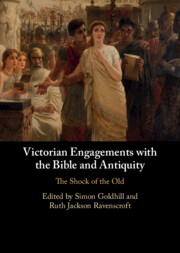Book contents
- Victorian Engagements with the Bible and Antiquity
- Victorian Engagements with the Bible and Antiquity
- Copyright page
- Contents
- Figures
- Contributors
- Acknowledgements
- 1 Introduction
- Part I Antiquity’s Modernity
- Part II Making the Past Visible
- Part III Materiality and Spectacle
- 6 Dionysia in Bavaria
- 7 ‘Popes and Caesars’
- Part IV Travelling the World
- Part V Manuscripts, Morality, and Metaphysics
- Part VI Intellectual Superstars
- Bibliography
- Index
7 - ‘Popes and Caesars’
St Paul, Protestant Bible Culture, and the Building of the American Episcopal Church in Rome
from Part III - Materiality and Spectacle
Published online by Cambridge University Press: 28 September 2023
- Victorian Engagements with the Bible and Antiquity
- Victorian Engagements with the Bible and Antiquity
- Copyright page
- Contents
- Figures
- Contributors
- Acknowledgements
- 1 Introduction
- Part I Antiquity’s Modernity
- Part II Making the Past Visible
- Part III Materiality and Spectacle
- 6 Dionysia in Bavaria
- 7 ‘Popes and Caesars’
- Part IV Travelling the World
- Part V Manuscripts, Morality, and Metaphysics
- Part VI Intellectual Superstars
- Bibliography
- Index
Summary
In late nineteenth-century Rome the synergies and contrasts between past and present, antiquity and the Bible, were vexed. Occasionally, the tensions spawned by these dualities erupted on to the surface of the city as material excrescence. Perhaps the most conspicuous manifestation of this was architecture. The case of St Paul’s Within-the-Walls – the spectacular High Victorian church designed for the American Episcopal Church in Rome by the famous English architect George Edmund Street – is a prime example. The church’s incumbent, the Rev. Robert Jenkins Nevin, sought to mark the building as a symbol of liberty and modernity in what he and his congregation perceived as the ancient corruptions of Papal Rome. Themes concerning history, religious politics, architecture, and the city were marshalled and mingled in an effort to make plain the distinction between conservative and progressive culture in the ‘new’ Italy. In this contested milieu the historic figure of St Paul was appealed to as a precursor to the inherent liberalism of bible-oriented Protestantism, with the religious liberty it enshrined posited as the only possible future for religious order. This essay explores these themes and their concomitant tensions and contradictions through the politics surrounding Nevin’s vision for this landmark building in the city of ‘Popes and Caesars’.
- Type
- Chapter
- Information
- Victorian Engagements with the Bible and AntiquityThe Shock of the Old, pp. 184 - 208Publisher: Cambridge University PressPrint publication year: 2023



